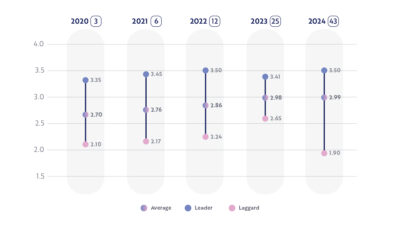
The hype around AI is deafening.
Every boardroom is talking about it. Every strategy deck has a slide on it. Every vendor claims to have it. And yet, in our work with dozens of organizations—from manufacturing and logistics to pharma and insurance—we see the same pattern over and over again:
Companies are rushing into AI without being ready for it.
They don’t have the data quality.
They lack proper governance.
They haven’t defined ownership.
They skip the boring but essential work—and then wonder why their AI projects stall, underperform, or silently die.
But there’s a better way.
This is the story of how one forward-thinking insurance company avoided that trap—and turned AI ambition into real business value.
Case Study: When AI Ambition Meets Reality
This mid-sized insurance firm had been investing in AI for two years. They had launched five pilots across fraud detection, customer service automation, underwriting risk analysis, churn prediction, and document processing.
The results? Mixed at best.
The fraud detection pilot showed promise but had false positive rates too high to deploy.
The chatbot in customer service could handle FAQs—but broke down on anything complex.
The underwriting model lacked explainability, triggering regulatory concerns.
The data science team was frustrated. Business units weren’t engaging.
The COO said, “AI sounds great—but what are we actually getting from it?”
What they needed wasn’t another use case.
They needed to step back and assess their readiness.
Enter the AI Maturity Index
We introduced the organization to Digitopia’s AI Maturity Index (AIMI), a structured framework to assess AI readiness across six dimensions: Strategy, Value, Data, Technology, Capabilities, and Governance.
We brought together 16 leaders—representing IT, data, legal, claims, underwriting, operations, and customer service—for a moderated self-assessment session.
Within 90 minutes, the room was buzzing.
The head of compliance admitted they hadn’t been involved in AI governance discussions.
The data engineering team revealed critical data silos that affected model training.
The claims director learned—during the session—that a document automation pilot was running in her department without her knowledge.
The final maturity score: 2.3 out of 5
The consensus takeaway: “We’ve been building AI on shaky ground.”
Clarity Before Scale
The Strategy Cockpit visualized their results, compared them to industry benchmarks, and offered targeted recommendations.
Instead of launching more pilots, the leadership team agreed to:
- Define and embed a clear AI governance framework, co-owned by risk, legal, IT, and business.
- Invest in data quality improvements for key customer, claims, and policy datasets.
- Consolidate AI pilots under a single AI Value Office, with a portfolio view of ROI.
- Appoint business unit sponsors for each AI use case—to ensure adoption and alignment.
- Re-assess their AI maturity every six months to track progress and guide prioritization.
This was not flashy. But it was transformational.
Unsure If Your AI Initiatives Are Built on Solid Ground?
AI doesn’t work without the right foundation. Assess your AI readiness across data, governance, and strategy with our AI Maturity solution and scale with confidence—not chaos.
The Business Impact of Doing AI Right
Within six months, the company relaunched its fraud detection initiative—this time with clean data, clear governance, and a cross-functional team.
The results:
✔️ False positives reduced by 61%
✔️ Detection precision increased to 92%
✔️ Estimated fraud prevention impact: $3.4M in the first year
The document automation pilot, now under proper sponsorship and workflow redesign, was scaled across three lines of business—reducing manual claims processing effort by 38%, saving another $1.8M annually.
Meanwhile, they postponed the chatbot expansion and underwriting automation—until data and regulatory concerns could be resolved. A smart call that saved millions in potential reputational and legal risk.
Lessons in AI Readiness
Here’s what this company learned—and what every organization should consider before going all-in on AI:
1. AI requires strong data, not just smart models.
The best algorithms in the world are useless if your data is incomplete, biased, or inconsistent. Before scaling AI, fix your data infrastructure. In this case, improving claims data lineage directly boosted fraud detection accuracy.
2. Governance is not optional.
AI raises ethical, legal, and regulatory risks. Without proper oversight, you expose your business to serious consequences. Embedding compliance, risk, and legal from day one turned a potential weakness into a strength.
3. Business adoption is everything.
AI is not an IT project. If business units don’t trust, understand, or own the outcomes, the models won’t get used. That’s why aligning ownership and sponsorship was a game-changer.
4. Focus beats frenzy.
They stopped spreading resources across five pilots. Instead, they focused on two, delivered results, and earned internal credibility to do more later.
5. Maturity is measurable—and it matters.
Their low AIMI score wasn’t an indictment. It was a wake-up call. And by measuring again every six months, they created a rhythm of reflection, course correction, and improvement.
Measuring Readiness = Reducing Risk
In AI, experimentation is valuable—but blind experimentation is costly.
Every failed pilot consumes budget, time, and trust.
Every model that never makes it to production is a wasted opportunity.
Every compliance gap is a potential crisis.
That’s why AI maturity assessment is not a luxury. It’s risk management. It’s strategy. It’s discipline.
And it pays off.
From Technology to Tangible Value
Too often, AI is treated as a technology story. But the real story is business value.
This company didn’t achieve results by building better models.
They achieved results by building the right foundation—one aligned with their operating model, risk posture, data reality, and strategic priorities.
They didn’t bet on magic. They measured maturity.
And that made all the difference.
Scaling with Confidence
One year later, the company is in a different place.
Their AIMI score is now 3.1.
Their AI Value Office runs quarterly reviews of the use case portfolio.
They’ve launched a Responsible AI training program for leaders.
They’re exploring generative AI—but with a clear guardrail framework.
They still experiment—but they do it with purpose.
They still invest—but they do it with control.
They still move fast—but not recklessly.
That’s what real AI maturity looks like.
What’s Measured Gets Done
This story is a reminder of one of the most important truths in modern business:
If you don’t measure your readiness, you can’t manage your risk—or maximize your results.
AI offers incredible potential. But only to organizations that are ready for it.
Maturity models aren’t constraints—they’re enablers.
Benchmarking isn’t a vanity metric—it’s a mirror.
And structured assessment isn’t a delay—it’s a fast track to doing things right.
Before you scale AI, measure your readiness. Before you build the future, strengthen your foundation.
AI isn’t magic. But when you do it right, the results feel magical.




